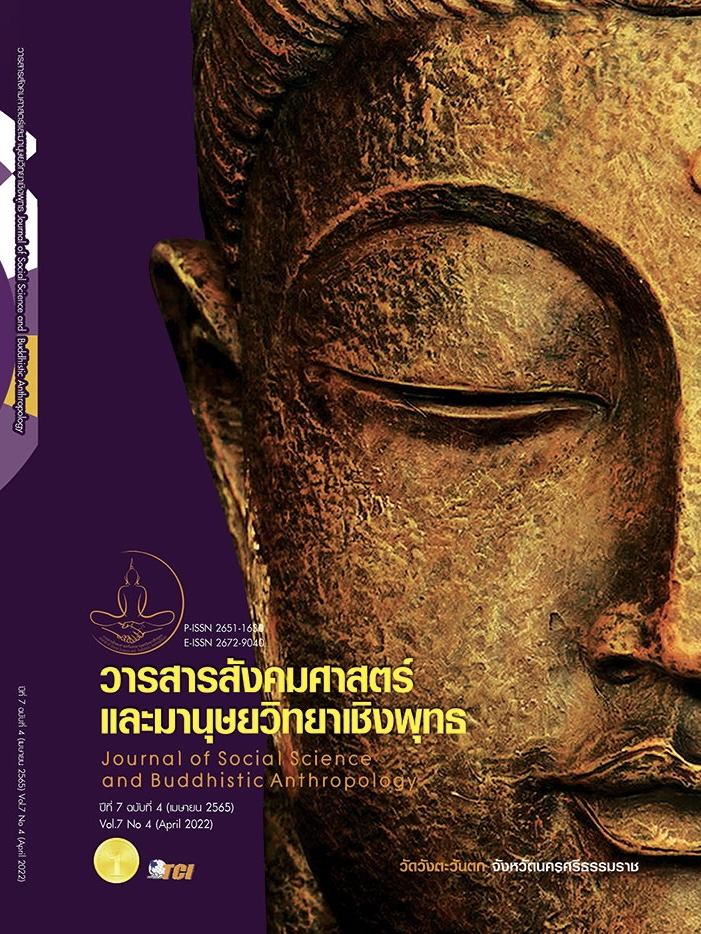THE DYNAMICS OF THE CULTURE OF USING “TUNG” WITH TH TRADITION OF “HEET SIPSONG” IN THE CONTEXT OF NORTHEASTERN CULTRAL SOCIETY
Keywords:
Tung, Heet Sipsong, Dynamics of The Culture of Using TungAbstract
The objectives of this research article were to study the culture of using Tung – Flag with the Heet Sipsong – The Twelve Isan Merit-Making Traditions and to analyze the dynamics of the culture of using the Tung that appeared in Heet Sipsong tradition. It is a qualitative research by studying the documents and related research, target group interviewing of 10 person and observation in order to bring the data to analyze the content and present it in descriptive analysis. The results showed that, 1) Heet Sipsong tradition that Tung has taken a part in as follows, 1) In Boon Khun Lan, Tung was used as a symbol of the animals of the eight directions according to the Lan Chang culture that believes that able to bring fertility to the produce. 2) In Boon Phawet, Tung was used as part of a Kha Tha Phan sacrifice – The preaching of 1000 chapters of Mahavessandorn Jataka and used to decorate the Rong Tham pavilion to simulate the place to be like a maze in Mahavessandorn Jataka – tales of the lord Buddha's former births. 3) In Boon Songkran, Tung was used to decorate sand pagodas to offer as offerings to the Buddha. 4) In Boon Samha, Tung was used as a symbol to prevent bad luck. 5) In Boon Kathin, Tung was used as a symbol for the temple where the Kathin ceremony has been completed. 2) The culture of using Tung with the Heet Sipsong tradition, for example, some types of Tungs have begun to disappear from the Heet Sipsong tradition and other objects have been replaced. In addition, there is also the use of waste materials such as fabric to create a Tung. And apply a Tung in accordance with the context of traditions, such as applying a Tung from Boon Songkran to use in funeral ceremony. As well as using of natural or local materials to invent as a Tung for use in ritual.
References
กิตติ วัฒนะมหาตม์. (2547). คู่มือบูชาเทพ. กรุงเทพมหานคร: สร้างสรรค์บุ๊คส์.
ฉลอง พันธ์จันทร์. (2562). เอกสารคำสอนรายวิชา 0114115 พุทธศาสนาในบริบทวัฒนธรรมท้องถิ่น. มหาสารคาม: คณะมนุษยศาสตร์และสังคมศาสตร์ มหาวิทยาลัยมหาสารคาม.
ชไมพร พรเพ็ญพิพัฒน์. (2546). ตุง มรดกแผ่นล้านนา. กรุงเทพมหานคร: สำนักพิมพ์ที เจเจ จำกัด.
ธวัช ปุณโณทก. (2531). ความเชื่อพื้นบ้านอันสัมพันธ์กับวิถีชีวิตในสังคมอีสาน. กรุงเทพมหานคร: โรงพิมพ์แห่งจุฬาลงกรณ์มหาวิทยาลัย.
บุญส่ง ศรีจันทร์. (10 กุมภาพันธ์ 2563). ธุงช่อเป็นหนึ่งในคายผะเหวด. (นายสิทธิชัย ระหาญนอก, ผู้สัมภาษณ์)
ประทับใจ สุวรรณธาดา. (2561). ธุงอีสาน. (พิมพ์ครั้งที่ 2). อุบลราชธานี: ศิริธรรมออฟเซ็ท.
ปรีชา พิณทอง. (2534). ประเพณีโบราณไทยอีสาน. อุบลราชธานี: ศิริธรรมออฟเซท.
พระครูปริยัติเจติยานุกูล (เจษฎา นรินฺโท). (12 ตุลาคม 2563). ความหมายของธุงกฐิน. (นายสิทธิชัย ระหาญนอก, ผู้สัมภาษณ์)
พระครูเมตตาคุณาภรณ์. (26 ตุลาคม 2563). บทบาทของธุงในพิธีเผาศพ. (นายสิทธิชัย ระหาญนอก, ผู้สัมภาษณ์)
พระครูวรธรรมธัช (วรวิทย์ ธมฺมจาโร). (15 กรกฎาคม 2564). คติการปักธุงบนเจดีย์ทราย. (นายสิทธิชัย ระหาญนอก, ผู้สัมภาษณ์)
พระมหาโพธิวงศาจารย์ (ทองดี สุรเตโช). (2559). พจนานุกรม ไทย-บาลี. กรุงเทพมหานคร: บริษัท ปัญจมิตรการพิมพ์.
พระยาอนุมานราชธน (ยง เสฐียรโกเศศ). (2505). การศึกษาเรื่องประเพณีไทย. กรุงเทพมหานคร: ราชบัณฑิตยสถาน.
พระยาอนุมานราชธน (ยง เสฐียรโกเศศ). (2508). ประเพณีเบ็ดเตล็ด. กรุงเทพมหานคร: โรงพิมพ์สมาคมสังคมศาสตร์แห่งประเทศไทย.
พระรัตนากรวิสุทธิ์ (มณีรัตน์ ติกฺขวีโร). (13 เมษายน 2563). คติการปักธุงบนเจดีย์ทราย. (นายสิทธิชัย ระหาญนอก, ผู้สัมภาษณ์)
พระอริยานุวัตร (อารีย์ เขมจารี). (2506). ระเบียบโบราณประเพณีทำบุญมหาชาติภาคอิสาน. กรุงเทพมหานคร: วัดพิชัยญาติการามวรวิหาร.
ภูวดล อยู่ปาน. (15 กรกฎาคม 2562). สัญลักษณ์บนธุงตัวพึ่ง. (นายสิทธิชัย ระหาญนอก, ผู้สัมภาษณ์)
มนัส สุขสาย. (2546). ภูมิปัญญาไทอีสาน. อุบลราชธานี: ศูนย์การศึกษานอกโรงเรียนภาคตะวันออกเฉียงเหนือ.
มหาจุฬาลงกรณราชวิทยาลัย. (2539). พระไตรปิฎกภาษาไทย ฉบับมหาจุฬาลงกรณราชวิทยาลัย เล่ม 15. กรุงเทพมหานคร: มหาจุฬาลงกรณราชวิทยาลัย.
มูลนิธิสารานุกรมวัฒนธรรมไทย ธนาคารไทยพาณิชย์. (2542). สารานุกรมวัฒนธรรมไทยภาคเหนือ. กรุงเทพมหานคร: มูลนิธิสารานุกรมวัฒนธรรมไทย ธนาคารไทยพาณิชย์.
ยุทธพงศ์ มาตย์วิเศษ. (22 ตุลาคม 2562). บทบาทของธุงในบุญแจกข้าว. (นายสิทธิชัย ระหาญนอก, ผู้สัมภาษณ์)
ราชบัณฑิตยสถาน. (2556). พจนานุกรมฉบับราชบัณฑิตยสถาน พ.ศ.2554. กรุงเทพมหานคร: ราชบัณฑิตยสถาน.
วิรัตน์ โพธ์ศรีเรือง. (15 กรกฎาคม 2562). บทบาทของธุงตัวพึ่งในบุญคูณลาน. (นายสิทธิชัย ระหาญนอก, ผู้สัมภาษณ์)
วีณา วีสเพ็ญ. (2562). ธุง หรือ ทุง และ ปะคือ ความหมาย ความสำคัญ ในบริบทมรดกทางวัฒนธรรม. มหาสารคาม: สถาบันวิจัยศิลปะและวัฒนธรรมอีสาน มหาวิทยาลัยมหาสารคาม.
สมชาย นิลอาธิ. (2539). ฮีตสิบสองและคองสิบสี่. วารสารมหาวิทยาลัยมหาสารคาม, 5(1), 15-21.
สมศักดิ์ พรมแก้ว. (11 ตุลาคม 2563). นัยการยกธุงผ้าขาวในบุญกฐินอุทิศ. (นายสิทธิชัย ระหาญนอก, ผู้สัมภาษณ์)
อภิญวัฒน์ โพธิ์สาน. (31 กรกฎาคม 2562). ภาษาบาลีของคำว่าธุงผ้าพระบฏ. (นายสิทธิชัย ระหาญนอก, ผู้สัมภาษณ์)
Downloads
Published
How to Cite
Issue
Section
License
Copyright (c) 2022 Journal of Social Science and Buddhistic Anthropology

This work is licensed under a Creative Commons Attribution-NonCommercial-NoDerivatives 4.0 International License.








